Marketing Essentials for Travel and Tourism: TUI Analysis Report
VerifiedAdded on 2021/02/20
|15
|4645
|26
Report
AI Summary
This report provides a comprehensive analysis of marketing essentials within the travel and tourism industry, focusing on TUI AG. It begins with an introduction to marketing and its importance, followed by an explanation of the key roles and responsibilities of the marketing function, including research, brand management, and product development. The report then delves into the relationship between marketing and other organizational units such as sales, HR, and finance, highlighting how these functions interrelate. Furthermore, it examines the marketing environment, discussing information systems, monitoring, and segmentation. A key section compares TUI's and Booking.com's use of the marketing mix elements (product, price, place, promotion, people), offering insights into their distinct strategies. Finally, the report concludes with the development of a basic marketing plan tailored to meet TUI's business objectives, providing a practical application of the concepts discussed throughout the analysis.
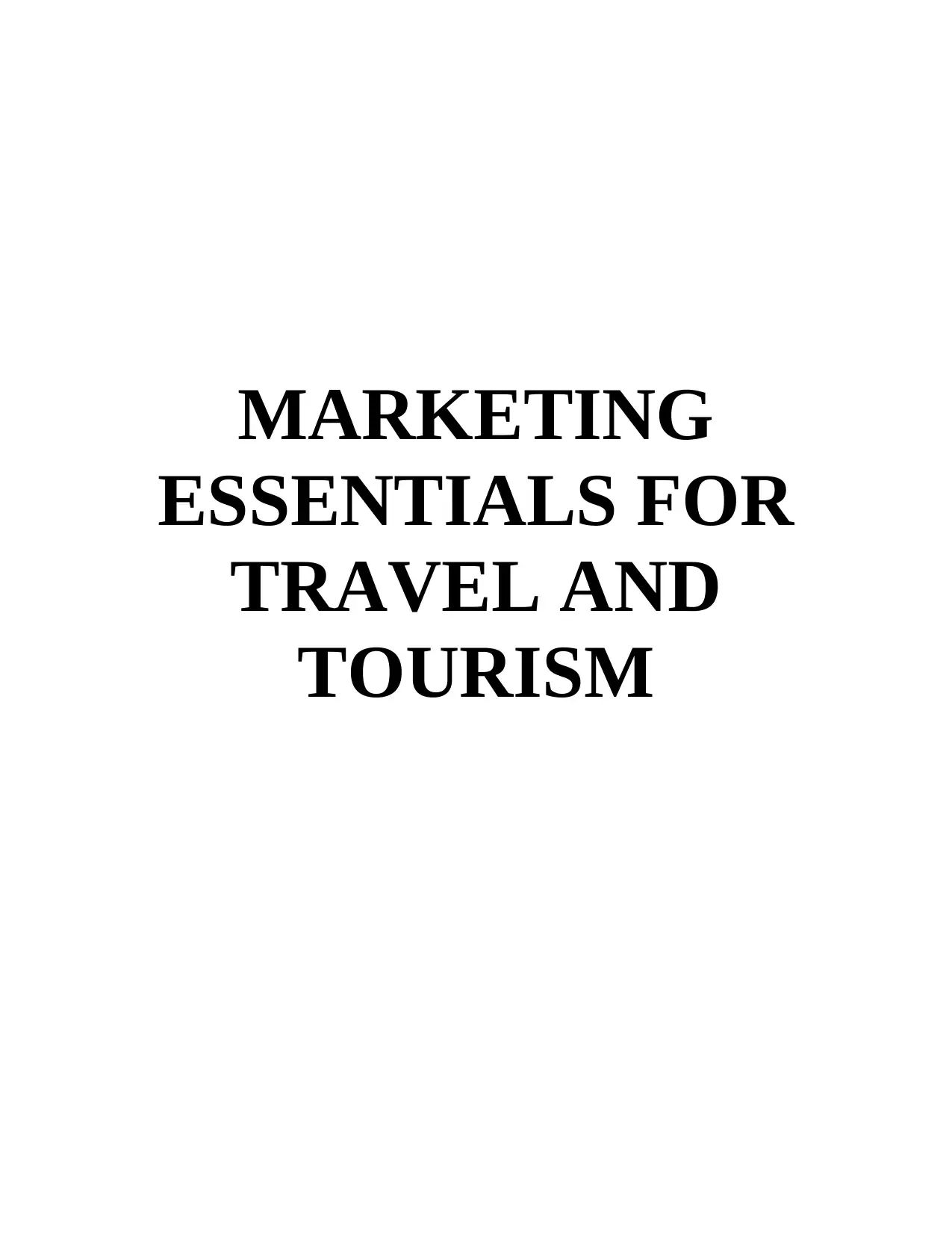
MARKETING
ESSENTIALS FOR
TRAVEL AND
TOURISM
ESSENTIALS FOR
TRAVEL AND
TOURISM
Paraphrase This Document
Need a fresh take? Get an instant paraphrase of this document with our AI Paraphraser
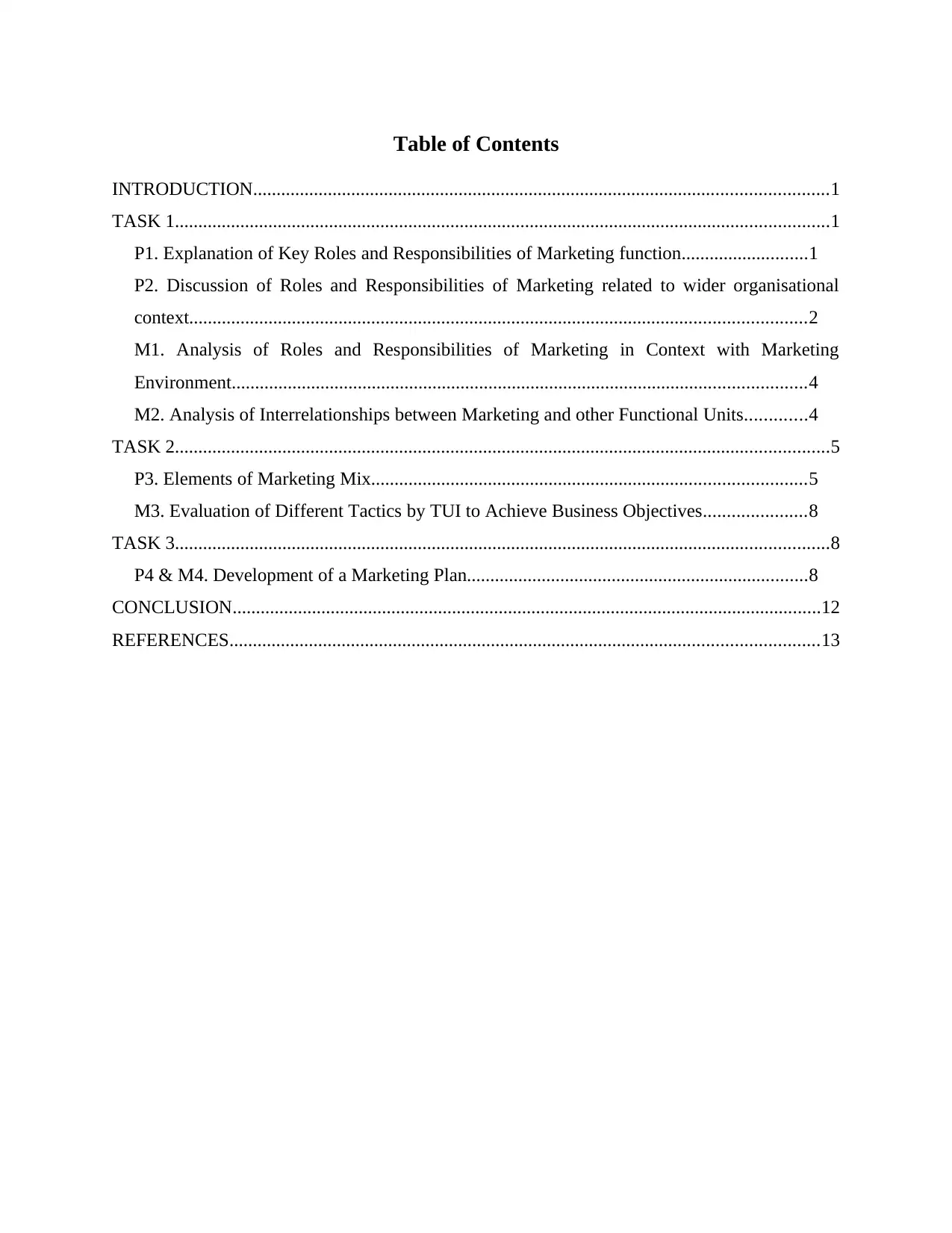
Table of Contents
INTRODUCTION...........................................................................................................................1
TASK 1............................................................................................................................................1
P1. Explanation of Key Roles and Responsibilities of Marketing function...........................1
P2. Discussion of Roles and Responsibilities of Marketing related to wider organisational
context....................................................................................................................................2
M1. Analysis of Roles and Responsibilities of Marketing in Context with Marketing
Environment...........................................................................................................................4
M2. Analysis of Interrelationships between Marketing and other Functional Units.............4
TASK 2............................................................................................................................................5
P3. Elements of Marketing Mix.............................................................................................5
M3. Evaluation of Different Tactics by TUI to Achieve Business Objectives......................8
TASK 3............................................................................................................................................8
P4 & M4. Development of a Marketing Plan.........................................................................8
CONCLUSION..............................................................................................................................12
REFERENCES..............................................................................................................................13
INTRODUCTION...........................................................................................................................1
TASK 1............................................................................................................................................1
P1. Explanation of Key Roles and Responsibilities of Marketing function...........................1
P2. Discussion of Roles and Responsibilities of Marketing related to wider organisational
context....................................................................................................................................2
M1. Analysis of Roles and Responsibilities of Marketing in Context with Marketing
Environment...........................................................................................................................4
M2. Analysis of Interrelationships between Marketing and other Functional Units.............4
TASK 2............................................................................................................................................5
P3. Elements of Marketing Mix.............................................................................................5
M3. Evaluation of Different Tactics by TUI to Achieve Business Objectives......................8
TASK 3............................................................................................................................................8
P4 & M4. Development of a Marketing Plan.........................................................................8
CONCLUSION..............................................................................................................................12
REFERENCES..............................................................................................................................13
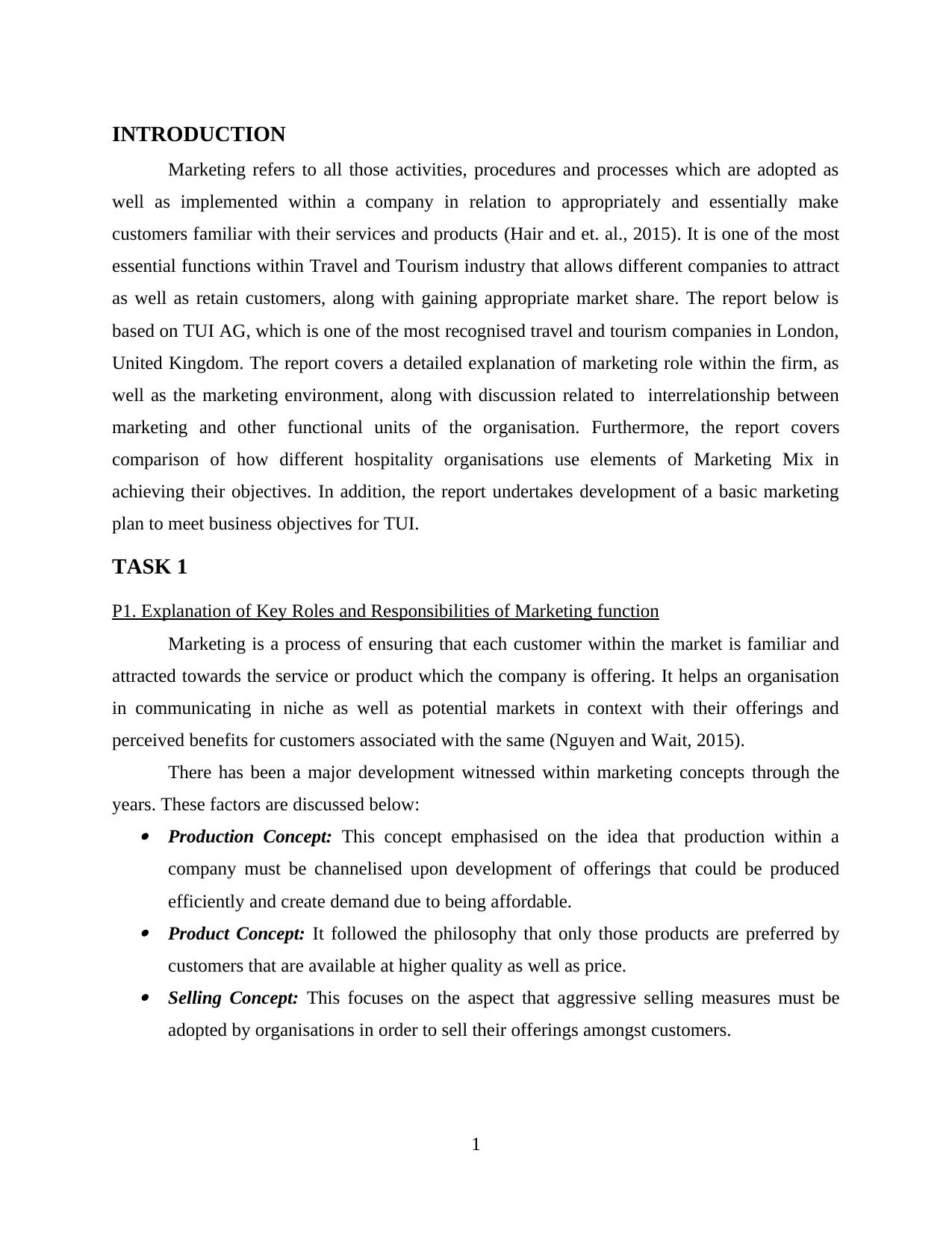
INTRODUCTION
Marketing refers to all those activities, procedures and processes which are adopted as
well as implemented within a company in relation to appropriately and essentially make
customers familiar with their services and products (Hair and et. al., 2015). It is one of the most
essential functions within Travel and Tourism industry that allows different companies to attract
as well as retain customers, along with gaining appropriate market share. The report below is
based on TUI AG, which is one of the most recognised travel and tourism companies in London,
United Kingdom. The report covers a detailed explanation of marketing role within the firm, as
well as the marketing environment, along with discussion related to interrelationship between
marketing and other functional units of the organisation. Furthermore, the report covers
comparison of how different hospitality organisations use elements of Marketing Mix in
achieving their objectives. In addition, the report undertakes development of a basic marketing
plan to meet business objectives for TUI.
TASK 1
P1. Explanation of Key Roles and Responsibilities of Marketing function
Marketing is a process of ensuring that each customer within the market is familiar and
attracted towards the service or product which the company is offering. It helps an organisation
in communicating in niche as well as potential markets in context with their offerings and
perceived benefits for customers associated with the same (Nguyen and Wait, 2015).
There has been a major development witnessed within marketing concepts through the
years. These factors are discussed below: Production Concept: This concept emphasised on the idea that production within a
company must be channelised upon development of offerings that could be produced
efficiently and create demand due to being affordable. Product Concept: It followed the philosophy that only those products are preferred by
customers that are available at higher quality as well as price. Selling Concept: This focuses on the aspect that aggressive selling measures must be
adopted by organisations in order to sell their offerings amongst customers.
1
Marketing refers to all those activities, procedures and processes which are adopted as
well as implemented within a company in relation to appropriately and essentially make
customers familiar with their services and products (Hair and et. al., 2015). It is one of the most
essential functions within Travel and Tourism industry that allows different companies to attract
as well as retain customers, along with gaining appropriate market share. The report below is
based on TUI AG, which is one of the most recognised travel and tourism companies in London,
United Kingdom. The report covers a detailed explanation of marketing role within the firm, as
well as the marketing environment, along with discussion related to interrelationship between
marketing and other functional units of the organisation. Furthermore, the report covers
comparison of how different hospitality organisations use elements of Marketing Mix in
achieving their objectives. In addition, the report undertakes development of a basic marketing
plan to meet business objectives for TUI.
TASK 1
P1. Explanation of Key Roles and Responsibilities of Marketing function
Marketing is a process of ensuring that each customer within the market is familiar and
attracted towards the service or product which the company is offering. It helps an organisation
in communicating in niche as well as potential markets in context with their offerings and
perceived benefits for customers associated with the same (Nguyen and Wait, 2015).
There has been a major development witnessed within marketing concepts through the
years. These factors are discussed below: Production Concept: This concept emphasised on the idea that production within a
company must be channelised upon development of offerings that could be produced
efficiently and create demand due to being affordable. Product Concept: It followed the philosophy that only those products are preferred by
customers that are available at higher quality as well as price. Selling Concept: This focuses on the aspect that aggressive selling measures must be
adopted by organisations in order to sell their offerings amongst customers.
1
⊘ This is a preview!⊘
Do you want full access?
Subscribe today to unlock all pages.

Trusted by 1+ million students worldwide
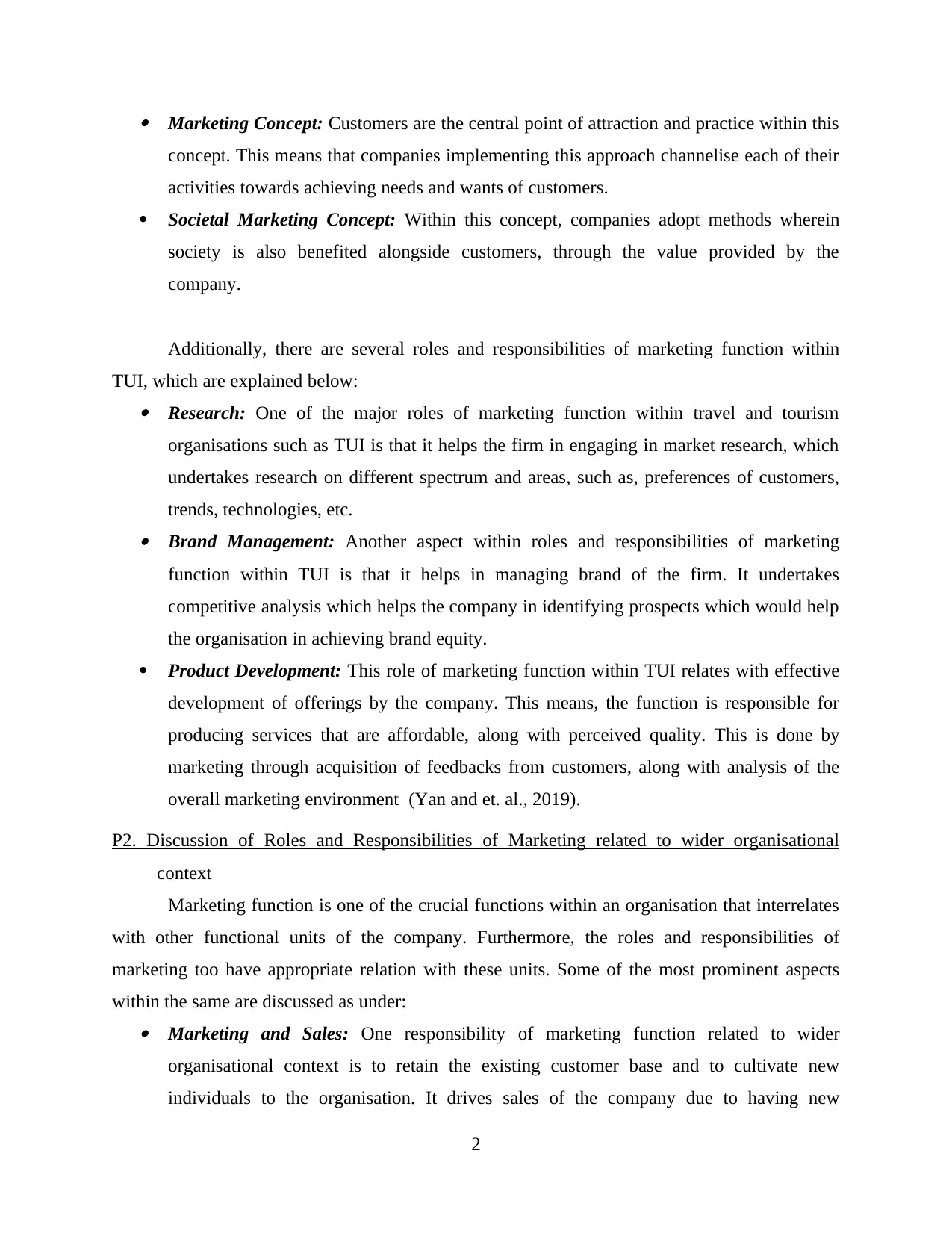
Marketing Concept: Customers are the central point of attraction and practice within this
concept. This means that companies implementing this approach channelise each of their
activities towards achieving needs and wants of customers.
Societal Marketing Concept: Within this concept, companies adopt methods wherein
society is also benefited alongside customers, through the value provided by the
company.
Additionally, there are several roles and responsibilities of marketing function within
TUI, which are explained below: Research: One of the major roles of marketing function within travel and tourism
organisations such as TUI is that it helps the firm in engaging in market research, which
undertakes research on different spectrum and areas, such as, preferences of customers,
trends, technologies, etc. Brand Management: Another aspect within roles and responsibilities of marketing
function within TUI is that it helps in managing brand of the firm. It undertakes
competitive analysis which helps the company in identifying prospects which would help
the organisation in achieving brand equity.
Product Development: This role of marketing function within TUI relates with effective
development of offerings by the company. This means, the function is responsible for
producing services that are affordable, along with perceived quality. This is done by
marketing through acquisition of feedbacks from customers, along with analysis of the
overall marketing environment (Yan and et. al., 2019).
P2. Discussion of Roles and Responsibilities of Marketing related to wider organisational
context
Marketing function is one of the crucial functions within an organisation that interrelates
with other functional units of the company. Furthermore, the roles and responsibilities of
marketing too have appropriate relation with these units. Some of the most prominent aspects
within the same are discussed as under: Marketing and Sales: One responsibility of marketing function related to wider
organisational context is to retain the existing customer base and to cultivate new
individuals to the organisation. It drives sales of the company due to having new
2
concept. This means that companies implementing this approach channelise each of their
activities towards achieving needs and wants of customers.
Societal Marketing Concept: Within this concept, companies adopt methods wherein
society is also benefited alongside customers, through the value provided by the
company.
Additionally, there are several roles and responsibilities of marketing function within
TUI, which are explained below: Research: One of the major roles of marketing function within travel and tourism
organisations such as TUI is that it helps the firm in engaging in market research, which
undertakes research on different spectrum and areas, such as, preferences of customers,
trends, technologies, etc. Brand Management: Another aspect within roles and responsibilities of marketing
function within TUI is that it helps in managing brand of the firm. It undertakes
competitive analysis which helps the company in identifying prospects which would help
the organisation in achieving brand equity.
Product Development: This role of marketing function within TUI relates with effective
development of offerings by the company. This means, the function is responsible for
producing services that are affordable, along with perceived quality. This is done by
marketing through acquisition of feedbacks from customers, along with analysis of the
overall marketing environment (Yan and et. al., 2019).
P2. Discussion of Roles and Responsibilities of Marketing related to wider organisational
context
Marketing function is one of the crucial functions within an organisation that interrelates
with other functional units of the company. Furthermore, the roles and responsibilities of
marketing too have appropriate relation with these units. Some of the most prominent aspects
within the same are discussed as under: Marketing and Sales: One responsibility of marketing function related to wider
organisational context is to retain the existing customer base and to cultivate new
individuals to the organisation. It drives sales of the company due to having new
2
Paraphrase This Document
Need a fresh take? Get an instant paraphrase of this document with our AI Paraphraser
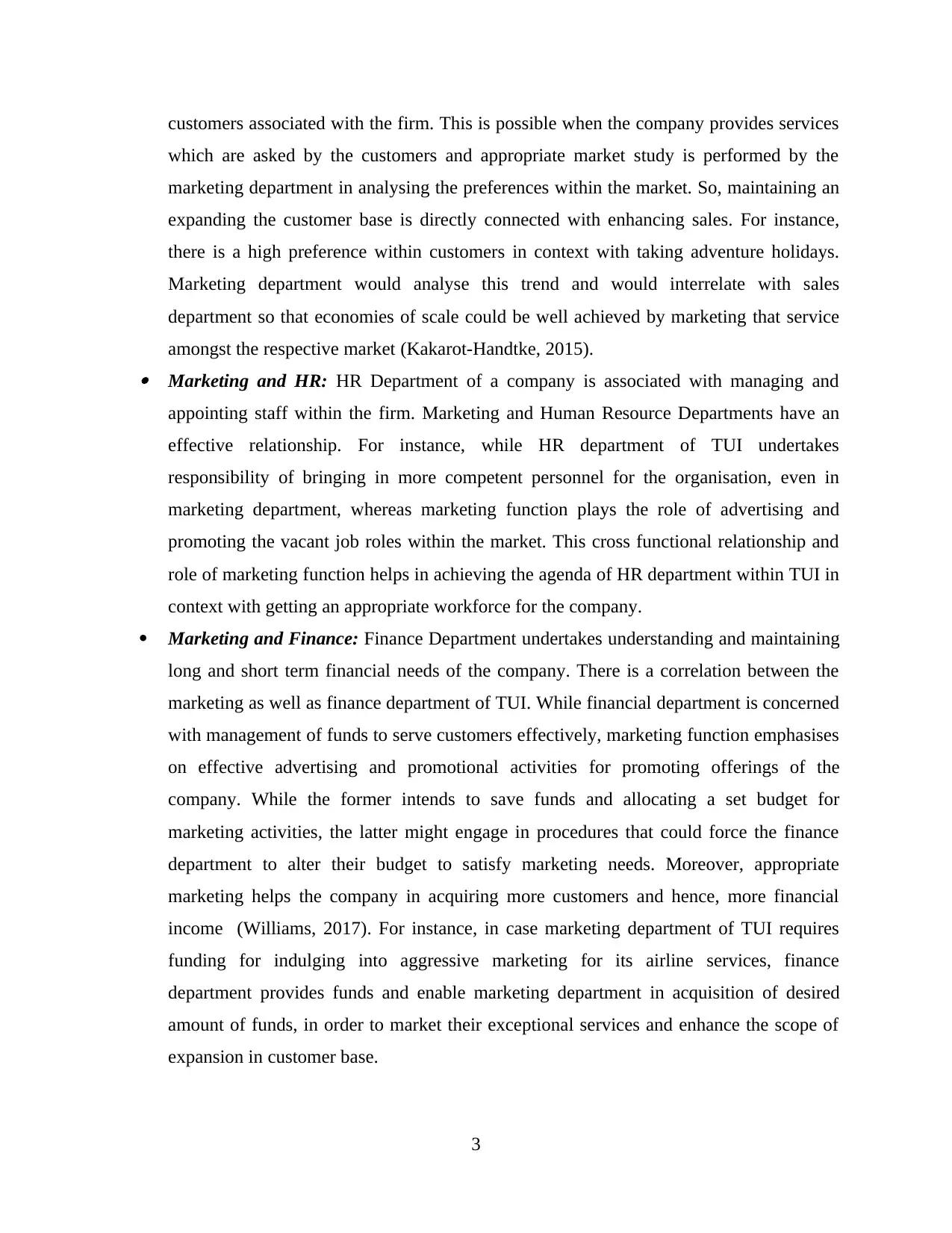
customers associated with the firm. This is possible when the company provides services
which are asked by the customers and appropriate market study is performed by the
marketing department in analysing the preferences within the market. So, maintaining an
expanding the customer base is directly connected with enhancing sales. For instance,
there is a high preference within customers in context with taking adventure holidays.
Marketing department would analyse this trend and would interrelate with sales
department so that economies of scale could be well achieved by marketing that service
amongst the respective market (Kakarot-Handtke, 2015). Marketing and HR: HR Department of a company is associated with managing and
appointing staff within the firm. Marketing and Human Resource Departments have an
effective relationship. For instance, while HR department of TUI undertakes
responsibility of bringing in more competent personnel for the organisation, even in
marketing department, whereas marketing function plays the role of advertising and
promoting the vacant job roles within the market. This cross functional relationship and
role of marketing function helps in achieving the agenda of HR department within TUI in
context with getting an appropriate workforce for the company.
Marketing and Finance: Finance Department undertakes understanding and maintaining
long and short term financial needs of the company. There is a correlation between the
marketing as well as finance department of TUI. While financial department is concerned
with management of funds to serve customers effectively, marketing function emphasises
on effective advertising and promotional activities for promoting offerings of the
company. While the former intends to save funds and allocating a set budget for
marketing activities, the latter might engage in procedures that could force the finance
department to alter their budget to satisfy marketing needs. Moreover, appropriate
marketing helps the company in acquiring more customers and hence, more financial
income (Williams, 2017). For instance, in case marketing department of TUI requires
funding for indulging into aggressive marketing for its airline services, finance
department provides funds and enable marketing department in acquisition of desired
amount of funds, in order to market their exceptional services and enhance the scope of
expansion in customer base.
3
which are asked by the customers and appropriate market study is performed by the
marketing department in analysing the preferences within the market. So, maintaining an
expanding the customer base is directly connected with enhancing sales. For instance,
there is a high preference within customers in context with taking adventure holidays.
Marketing department would analyse this trend and would interrelate with sales
department so that economies of scale could be well achieved by marketing that service
amongst the respective market (Kakarot-Handtke, 2015). Marketing and HR: HR Department of a company is associated with managing and
appointing staff within the firm. Marketing and Human Resource Departments have an
effective relationship. For instance, while HR department of TUI undertakes
responsibility of bringing in more competent personnel for the organisation, even in
marketing department, whereas marketing function plays the role of advertising and
promoting the vacant job roles within the market. This cross functional relationship and
role of marketing function helps in achieving the agenda of HR department within TUI in
context with getting an appropriate workforce for the company.
Marketing and Finance: Finance Department undertakes understanding and maintaining
long and short term financial needs of the company. There is a correlation between the
marketing as well as finance department of TUI. While financial department is concerned
with management of funds to serve customers effectively, marketing function emphasises
on effective advertising and promotional activities for promoting offerings of the
company. While the former intends to save funds and allocating a set budget for
marketing activities, the latter might engage in procedures that could force the finance
department to alter their budget to satisfy marketing needs. Moreover, appropriate
marketing helps the company in acquiring more customers and hence, more financial
income (Williams, 2017). For instance, in case marketing department of TUI requires
funding for indulging into aggressive marketing for its airline services, finance
department provides funds and enable marketing department in acquisition of desired
amount of funds, in order to market their exceptional services and enhance the scope of
expansion in customer base.
3
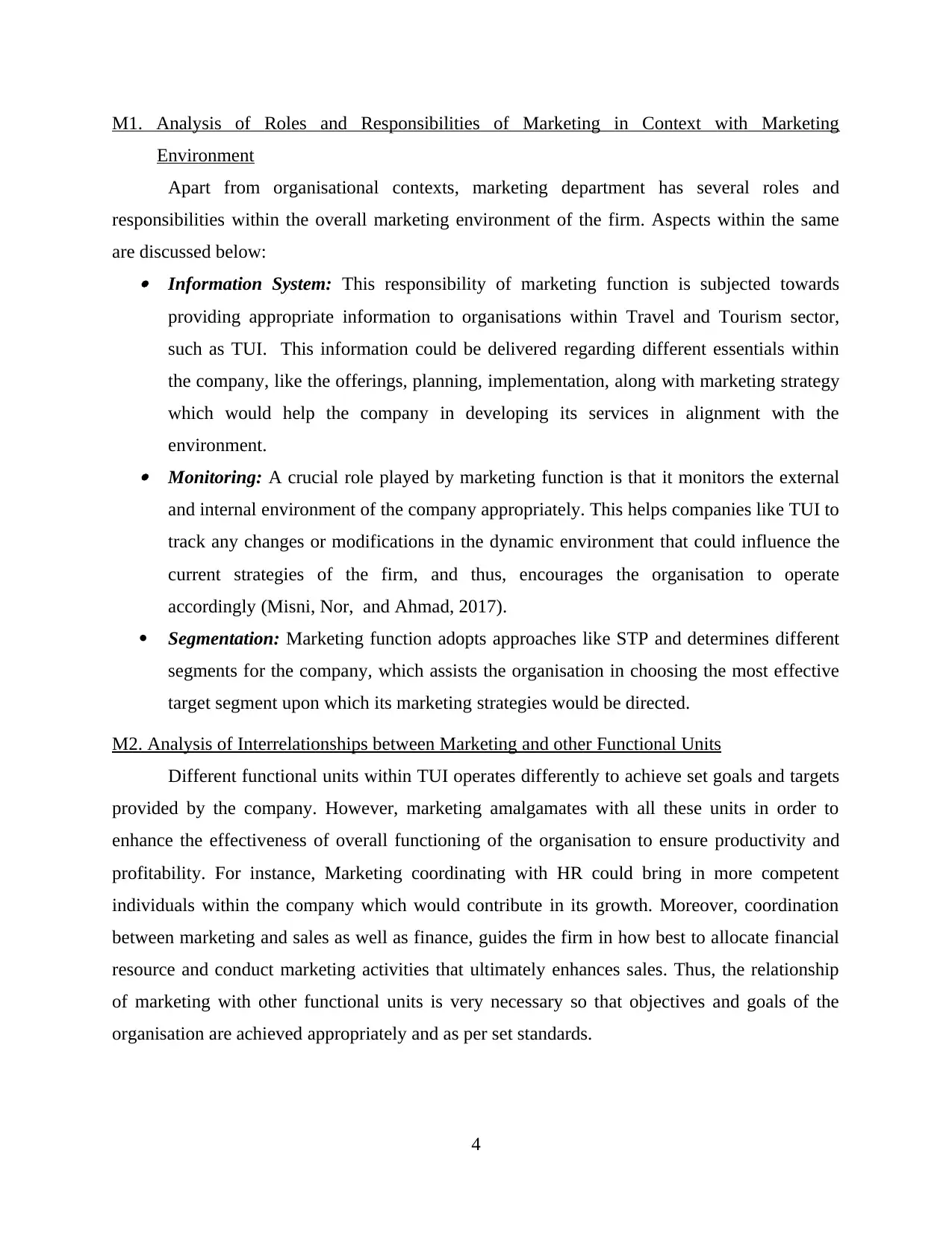
M1. Analysis of Roles and Responsibilities of Marketing in Context with Marketing
Environment
Apart from organisational contexts, marketing department has several roles and
responsibilities within the overall marketing environment of the firm. Aspects within the same
are discussed below: Information System: This responsibility of marketing function is subjected towards
providing appropriate information to organisations within Travel and Tourism sector,
such as TUI. This information could be delivered regarding different essentials within
the company, like the offerings, planning, implementation, along with marketing strategy
which would help the company in developing its services in alignment with the
environment. Monitoring: A crucial role played by marketing function is that it monitors the external
and internal environment of the company appropriately. This helps companies like TUI to
track any changes or modifications in the dynamic environment that could influence the
current strategies of the firm, and thus, encourages the organisation to operate
accordingly (Misni, Nor, and Ahmad, 2017).
Segmentation: Marketing function adopts approaches like STP and determines different
segments for the company, which assists the organisation in choosing the most effective
target segment upon which its marketing strategies would be directed.
M2. Analysis of Interrelationships between Marketing and other Functional Units
Different functional units within TUI operates differently to achieve set goals and targets
provided by the company. However, marketing amalgamates with all these units in order to
enhance the effectiveness of overall functioning of the organisation to ensure productivity and
profitability. For instance, Marketing coordinating with HR could bring in more competent
individuals within the company which would contribute in its growth. Moreover, coordination
between marketing and sales as well as finance, guides the firm in how best to allocate financial
resource and conduct marketing activities that ultimately enhances sales. Thus, the relationship
of marketing with other functional units is very necessary so that objectives and goals of the
organisation are achieved appropriately and as per set standards.
4
Environment
Apart from organisational contexts, marketing department has several roles and
responsibilities within the overall marketing environment of the firm. Aspects within the same
are discussed below: Information System: This responsibility of marketing function is subjected towards
providing appropriate information to organisations within Travel and Tourism sector,
such as TUI. This information could be delivered regarding different essentials within
the company, like the offerings, planning, implementation, along with marketing strategy
which would help the company in developing its services in alignment with the
environment. Monitoring: A crucial role played by marketing function is that it monitors the external
and internal environment of the company appropriately. This helps companies like TUI to
track any changes or modifications in the dynamic environment that could influence the
current strategies of the firm, and thus, encourages the organisation to operate
accordingly (Misni, Nor, and Ahmad, 2017).
Segmentation: Marketing function adopts approaches like STP and determines different
segments for the company, which assists the organisation in choosing the most effective
target segment upon which its marketing strategies would be directed.
M2. Analysis of Interrelationships between Marketing and other Functional Units
Different functional units within TUI operates differently to achieve set goals and targets
provided by the company. However, marketing amalgamates with all these units in order to
enhance the effectiveness of overall functioning of the organisation to ensure productivity and
profitability. For instance, Marketing coordinating with HR could bring in more competent
individuals within the company which would contribute in its growth. Moreover, coordination
between marketing and sales as well as finance, guides the firm in how best to allocate financial
resource and conduct marketing activities that ultimately enhances sales. Thus, the relationship
of marketing with other functional units is very necessary so that objectives and goals of the
organisation are achieved appropriately and as per set standards.
4
⊘ This is a preview!⊘
Do you want full access?
Subscribe today to unlock all pages.

Trusted by 1+ million students worldwide
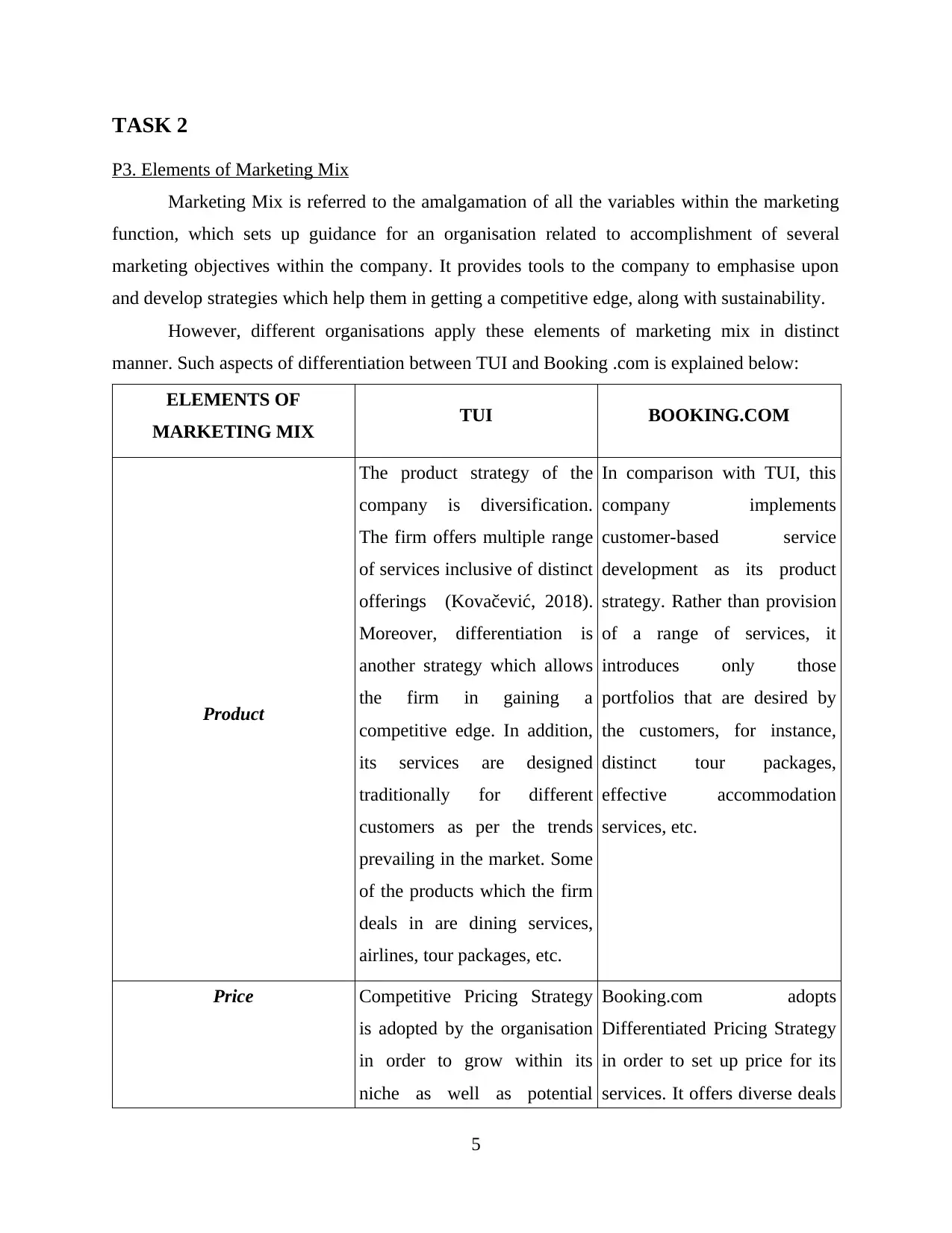
TASK 2
P3. Elements of Marketing Mix
Marketing Mix is referred to the amalgamation of all the variables within the marketing
function, which sets up guidance for an organisation related to accomplishment of several
marketing objectives within the company. It provides tools to the company to emphasise upon
and develop strategies which help them in getting a competitive edge, along with sustainability.
However, different organisations apply these elements of marketing mix in distinct
manner. Such aspects of differentiation between TUI and Booking .com is explained below:
ELEMENTS OF
MARKETING MIX TUI BOOKING.COM
Product
The product strategy of the
company is diversification.
The firm offers multiple range
of services inclusive of distinct
offerings (Kovačević, 2018).
Moreover, differentiation is
another strategy which allows
the firm in gaining a
competitive edge. In addition,
its services are designed
traditionally for different
customers as per the trends
prevailing in the market. Some
of the products which the firm
deals in are dining services,
airlines, tour packages, etc.
In comparison with TUI, this
company implements
customer-based service
development as its product
strategy. Rather than provision
of a range of services, it
introduces only those
portfolios that are desired by
the customers, for instance,
distinct tour packages,
effective accommodation
services, etc.
Price Competitive Pricing Strategy
is adopted by the organisation
in order to grow within its
niche as well as potential
Booking.com adopts
Differentiated Pricing Strategy
in order to set up price for its
services. It offers diverse deals
5
P3. Elements of Marketing Mix
Marketing Mix is referred to the amalgamation of all the variables within the marketing
function, which sets up guidance for an organisation related to accomplishment of several
marketing objectives within the company. It provides tools to the company to emphasise upon
and develop strategies which help them in getting a competitive edge, along with sustainability.
However, different organisations apply these elements of marketing mix in distinct
manner. Such aspects of differentiation between TUI and Booking .com is explained below:
ELEMENTS OF
MARKETING MIX TUI BOOKING.COM
Product
The product strategy of the
company is diversification.
The firm offers multiple range
of services inclusive of distinct
offerings (Kovačević, 2018).
Moreover, differentiation is
another strategy which allows
the firm in gaining a
competitive edge. In addition,
its services are designed
traditionally for different
customers as per the trends
prevailing in the market. Some
of the products which the firm
deals in are dining services,
airlines, tour packages, etc.
In comparison with TUI, this
company implements
customer-based service
development as its product
strategy. Rather than provision
of a range of services, it
introduces only those
portfolios that are desired by
the customers, for instance,
distinct tour packages,
effective accommodation
services, etc.
Price Competitive Pricing Strategy
is adopted by the organisation
in order to grow within its
niche as well as potential
Booking.com adopts
Differentiated Pricing Strategy
in order to set up price for its
services. It offers diverse deals
5
Paraphrase This Document
Need a fresh take? Get an instant paraphrase of this document with our AI Paraphraser
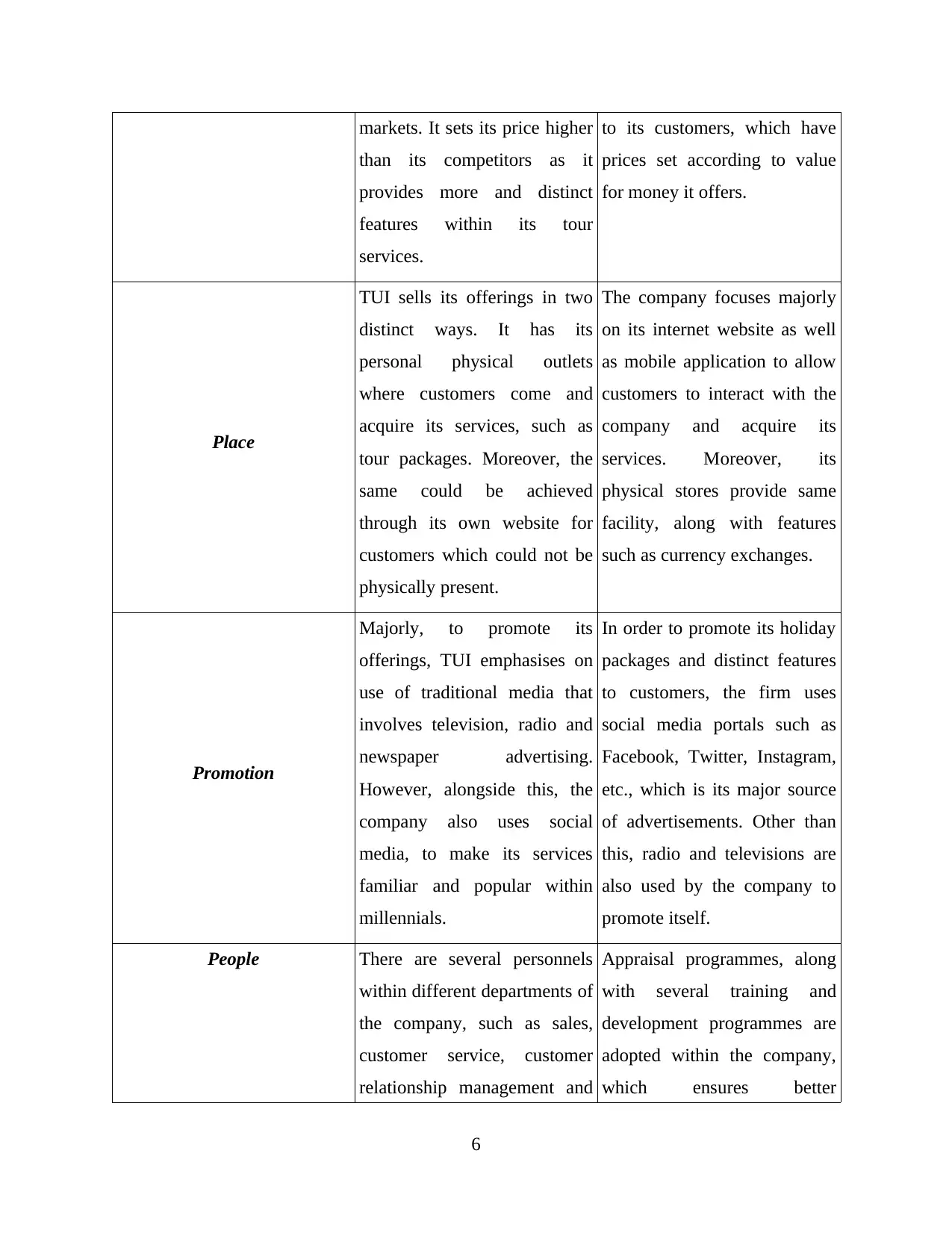
markets. It sets its price higher
than its competitors as it
provides more and distinct
features within its tour
services.
to its customers, which have
prices set according to value
for money it offers.
Place
TUI sells its offerings in two
distinct ways. It has its
personal physical outlets
where customers come and
acquire its services, such as
tour packages. Moreover, the
same could be achieved
through its own website for
customers which could not be
physically present.
The company focuses majorly
on its internet website as well
as mobile application to allow
customers to interact with the
company and acquire its
services. Moreover, its
physical stores provide same
facility, along with features
such as currency exchanges.
Promotion
Majorly, to promote its
offerings, TUI emphasises on
use of traditional media that
involves television, radio and
newspaper advertising.
However, alongside this, the
company also uses social
media, to make its services
familiar and popular within
millennials.
In order to promote its holiday
packages and distinct features
to customers, the firm uses
social media portals such as
Facebook, Twitter, Instagram,
etc., which is its major source
of advertisements. Other than
this, radio and televisions are
also used by the company to
promote itself.
People There are several personnels
within different departments of
the company, such as sales,
customer service, customer
relationship management and
Appraisal programmes, along
with several training and
development programmes are
adopted within the company,
which ensures better
6
than its competitors as it
provides more and distinct
features within its tour
services.
to its customers, which have
prices set according to value
for money it offers.
Place
TUI sells its offerings in two
distinct ways. It has its
personal physical outlets
where customers come and
acquire its services, such as
tour packages. Moreover, the
same could be achieved
through its own website for
customers which could not be
physically present.
The company focuses majorly
on its internet website as well
as mobile application to allow
customers to interact with the
company and acquire its
services. Moreover, its
physical stores provide same
facility, along with features
such as currency exchanges.
Promotion
Majorly, to promote its
offerings, TUI emphasises on
use of traditional media that
involves television, radio and
newspaper advertising.
However, alongside this, the
company also uses social
media, to make its services
familiar and popular within
millennials.
In order to promote its holiday
packages and distinct features
to customers, the firm uses
social media portals such as
Facebook, Twitter, Instagram,
etc., which is its major source
of advertisements. Other than
this, radio and televisions are
also used by the company to
promote itself.
People There are several personnels
within different departments of
the company, such as sales,
customer service, customer
relationship management and
Appraisal programmes, along
with several training and
development programmes are
adopted within the company,
which ensures better
6
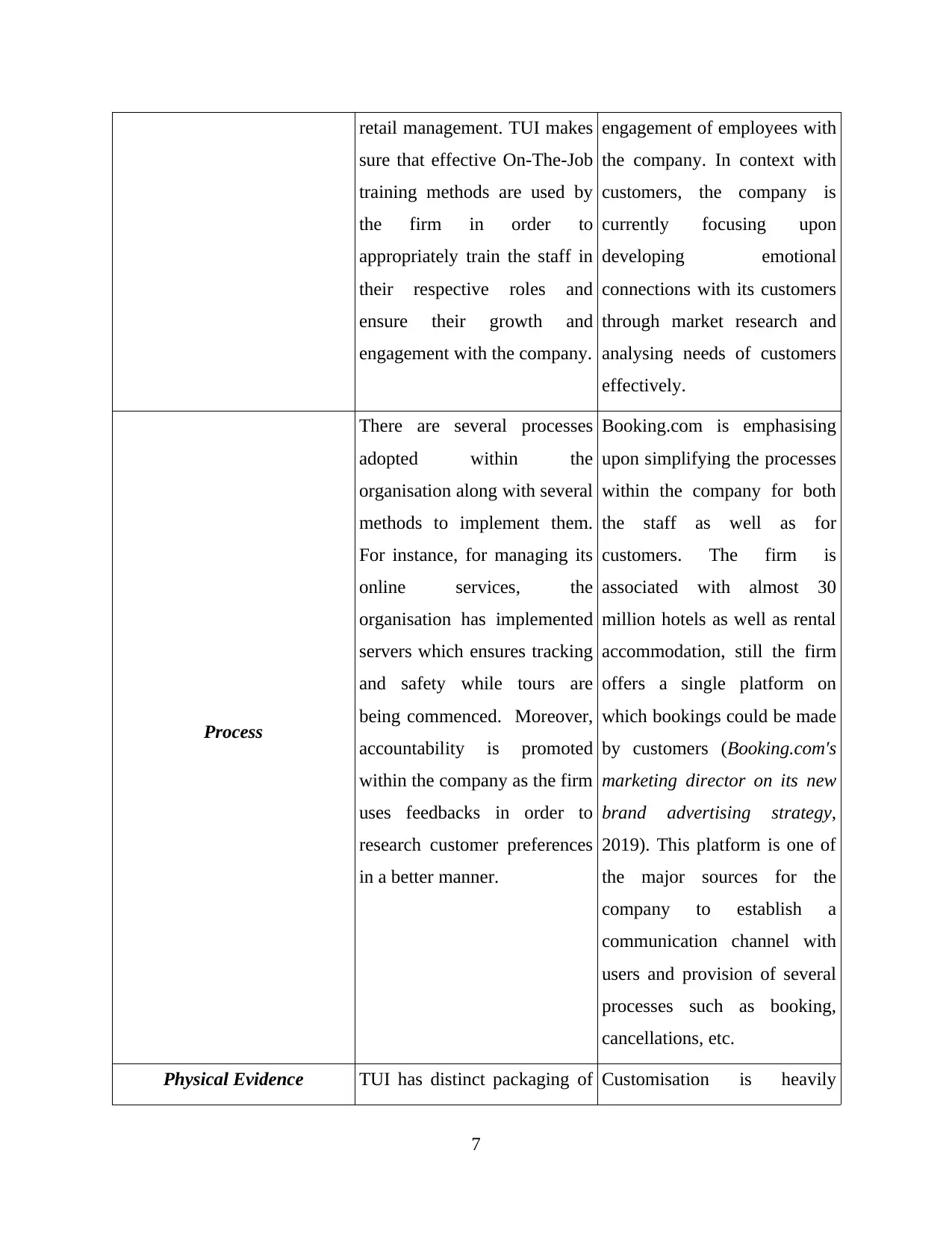
retail management. TUI makes
sure that effective On-The-Job
training methods are used by
the firm in order to
appropriately train the staff in
their respective roles and
ensure their growth and
engagement with the company.
engagement of employees with
the company. In context with
customers, the company is
currently focusing upon
developing emotional
connections with its customers
through market research and
analysing needs of customers
effectively.
Process
There are several processes
adopted within the
organisation along with several
methods to implement them.
For instance, for managing its
online services, the
organisation has implemented
servers which ensures tracking
and safety while tours are
being commenced. Moreover,
accountability is promoted
within the company as the firm
uses feedbacks in order to
research customer preferences
in a better manner.
Booking.com is emphasising
upon simplifying the processes
within the company for both
the staff as well as for
customers. The firm is
associated with almost 30
million hotels as well as rental
accommodation, still the firm
offers a single platform on
which bookings could be made
by customers (Booking.com's
marketing director on its new
brand advertising strategy,
2019). This platform is one of
the major sources for the
company to establish a
communication channel with
users and provision of several
processes such as booking,
cancellations, etc.
Physical Evidence TUI has distinct packaging of Customisation is heavily
7
sure that effective On-The-Job
training methods are used by
the firm in order to
appropriately train the staff in
their respective roles and
ensure their growth and
engagement with the company.
engagement of employees with
the company. In context with
customers, the company is
currently focusing upon
developing emotional
connections with its customers
through market research and
analysing needs of customers
effectively.
Process
There are several processes
adopted within the
organisation along with several
methods to implement them.
For instance, for managing its
online services, the
organisation has implemented
servers which ensures tracking
and safety while tours are
being commenced. Moreover,
accountability is promoted
within the company as the firm
uses feedbacks in order to
research customer preferences
in a better manner.
Booking.com is emphasising
upon simplifying the processes
within the company for both
the staff as well as for
customers. The firm is
associated with almost 30
million hotels as well as rental
accommodation, still the firm
offers a single platform on
which bookings could be made
by customers (Booking.com's
marketing director on its new
brand advertising strategy,
2019). This platform is one of
the major sources for the
company to establish a
communication channel with
users and provision of several
processes such as booking,
cancellations, etc.
Physical Evidence TUI has distinct packaging of Customisation is heavily
7
⊘ This is a preview!⊘
Do you want full access?
Subscribe today to unlock all pages.

Trusted by 1+ million students worldwide
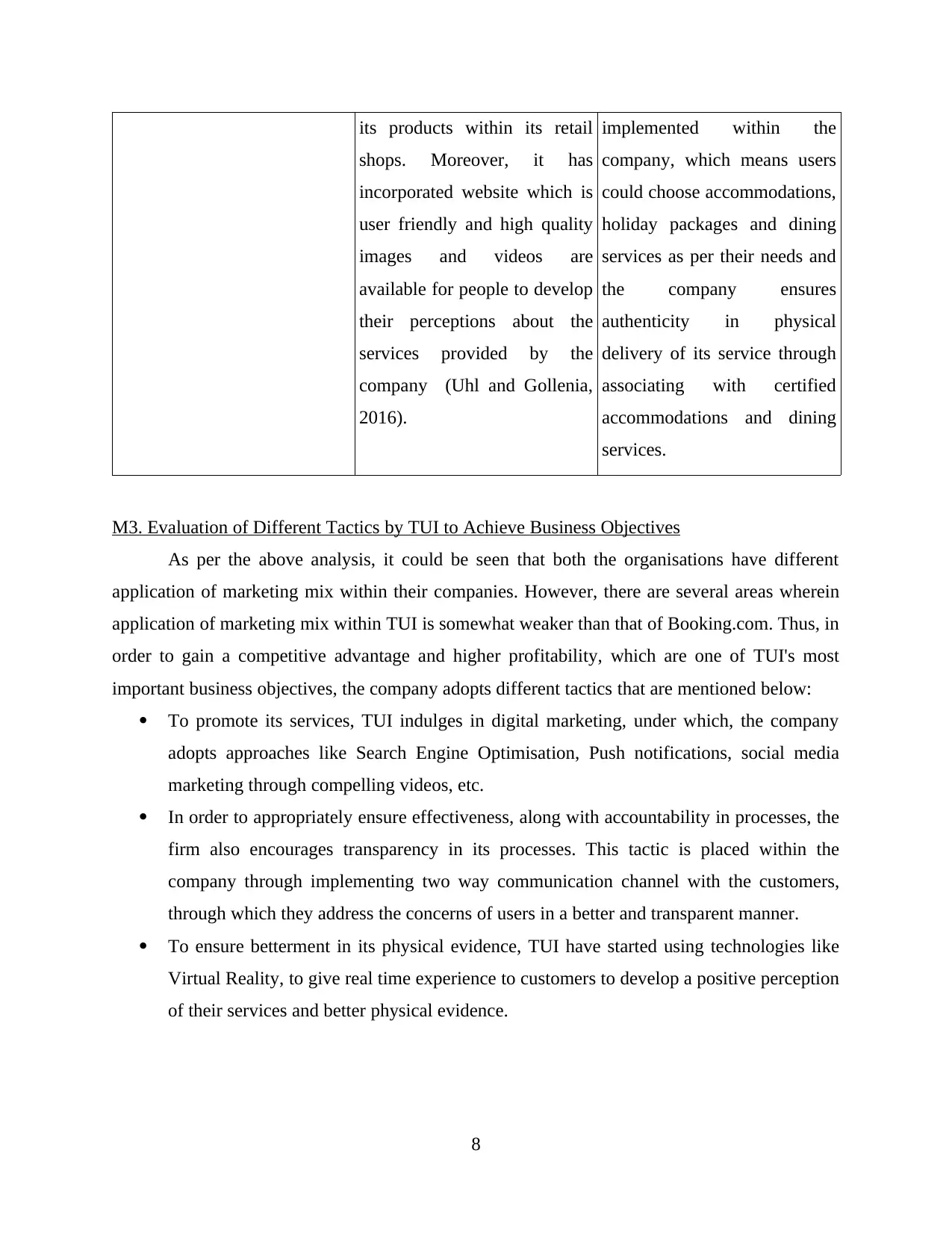
its products within its retail
shops. Moreover, it has
incorporated website which is
user friendly and high quality
images and videos are
available for people to develop
their perceptions about the
services provided by the
company (Uhl and Gollenia,
2016).
implemented within the
company, which means users
could choose accommodations,
holiday packages and dining
services as per their needs and
the company ensures
authenticity in physical
delivery of its service through
associating with certified
accommodations and dining
services.
M3. Evaluation of Different Tactics by TUI to Achieve Business Objectives
As per the above analysis, it could be seen that both the organisations have different
application of marketing mix within their companies. However, there are several areas wherein
application of marketing mix within TUI is somewhat weaker than that of Booking.com. Thus, in
order to gain a competitive advantage and higher profitability, which are one of TUI's most
important business objectives, the company adopts different tactics that are mentioned below:
To promote its services, TUI indulges in digital marketing, under which, the company
adopts approaches like Search Engine Optimisation, Push notifications, social media
marketing through compelling videos, etc.
In order to appropriately ensure effectiveness, along with accountability in processes, the
firm also encourages transparency in its processes. This tactic is placed within the
company through implementing two way communication channel with the customers,
through which they address the concerns of users in a better and transparent manner.
To ensure betterment in its physical evidence, TUI have started using technologies like
Virtual Reality, to give real time experience to customers to develop a positive perception
of their services and better physical evidence.
8
shops. Moreover, it has
incorporated website which is
user friendly and high quality
images and videos are
available for people to develop
their perceptions about the
services provided by the
company (Uhl and Gollenia,
2016).
implemented within the
company, which means users
could choose accommodations,
holiday packages and dining
services as per their needs and
the company ensures
authenticity in physical
delivery of its service through
associating with certified
accommodations and dining
services.
M3. Evaluation of Different Tactics by TUI to Achieve Business Objectives
As per the above analysis, it could be seen that both the organisations have different
application of marketing mix within their companies. However, there are several areas wherein
application of marketing mix within TUI is somewhat weaker than that of Booking.com. Thus, in
order to gain a competitive advantage and higher profitability, which are one of TUI's most
important business objectives, the company adopts different tactics that are mentioned below:
To promote its services, TUI indulges in digital marketing, under which, the company
adopts approaches like Search Engine Optimisation, Push notifications, social media
marketing through compelling videos, etc.
In order to appropriately ensure effectiveness, along with accountability in processes, the
firm also encourages transparency in its processes. This tactic is placed within the
company through implementing two way communication channel with the customers,
through which they address the concerns of users in a better and transparent manner.
To ensure betterment in its physical evidence, TUI have started using technologies like
Virtual Reality, to give real time experience to customers to develop a positive perception
of their services and better physical evidence.
8
Paraphrase This Document
Need a fresh take? Get an instant paraphrase of this document with our AI Paraphraser
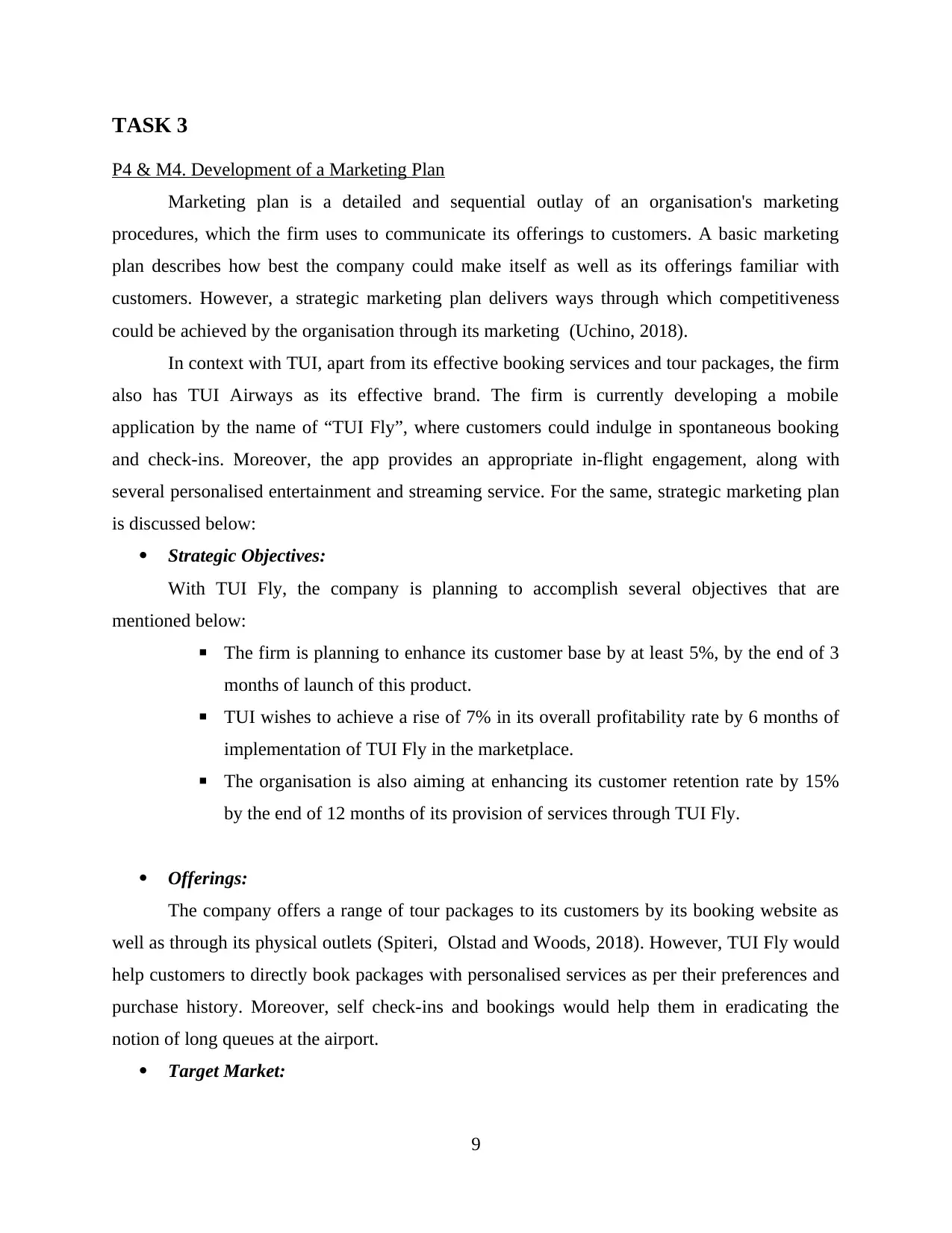
TASK 3
P4 & M4. Development of a Marketing Plan
Marketing plan is a detailed and sequential outlay of an organisation's marketing
procedures, which the firm uses to communicate its offerings to customers. A basic marketing
plan describes how best the company could make itself as well as its offerings familiar with
customers. However, a strategic marketing plan delivers ways through which competitiveness
could be achieved by the organisation through its marketing (Uchino, 2018).
In context with TUI, apart from its effective booking services and tour packages, the firm
also has TUI Airways as its effective brand. The firm is currently developing a mobile
application by the name of “TUI Fly”, where customers could indulge in spontaneous booking
and check-ins. Moreover, the app provides an appropriate in-flight engagement, along with
several personalised entertainment and streaming service. For the same, strategic marketing plan
is discussed below:
Strategic Objectives:
With TUI Fly, the company is planning to accomplish several objectives that are
mentioned below:
▪ The firm is planning to enhance its customer base by at least 5%, by the end of 3
months of launch of this product.
▪ TUI wishes to achieve a rise of 7% in its overall profitability rate by 6 months of
implementation of TUI Fly in the marketplace.
▪ The organisation is also aiming at enhancing its customer retention rate by 15%
by the end of 12 months of its provision of services through TUI Fly.
Offerings:
The company offers a range of tour packages to its customers by its booking website as
well as through its physical outlets (Spiteri, Olstad and Woods, 2018). However, TUI Fly would
help customers to directly book packages with personalised services as per their preferences and
purchase history. Moreover, self check-ins and bookings would help them in eradicating the
notion of long queues at the airport.
Target Market:
9
P4 & M4. Development of a Marketing Plan
Marketing plan is a detailed and sequential outlay of an organisation's marketing
procedures, which the firm uses to communicate its offerings to customers. A basic marketing
plan describes how best the company could make itself as well as its offerings familiar with
customers. However, a strategic marketing plan delivers ways through which competitiveness
could be achieved by the organisation through its marketing (Uchino, 2018).
In context with TUI, apart from its effective booking services and tour packages, the firm
also has TUI Airways as its effective brand. The firm is currently developing a mobile
application by the name of “TUI Fly”, where customers could indulge in spontaneous booking
and check-ins. Moreover, the app provides an appropriate in-flight engagement, along with
several personalised entertainment and streaming service. For the same, strategic marketing plan
is discussed below:
Strategic Objectives:
With TUI Fly, the company is planning to accomplish several objectives that are
mentioned below:
▪ The firm is planning to enhance its customer base by at least 5%, by the end of 3
months of launch of this product.
▪ TUI wishes to achieve a rise of 7% in its overall profitability rate by 6 months of
implementation of TUI Fly in the marketplace.
▪ The organisation is also aiming at enhancing its customer retention rate by 15%
by the end of 12 months of its provision of services through TUI Fly.
Offerings:
The company offers a range of tour packages to its customers by its booking website as
well as through its physical outlets (Spiteri, Olstad and Woods, 2018). However, TUI Fly would
help customers to directly book packages with personalised services as per their preferences and
purchase history. Moreover, self check-ins and bookings would help them in eradicating the
notion of long queues at the airport.
Target Market:
9
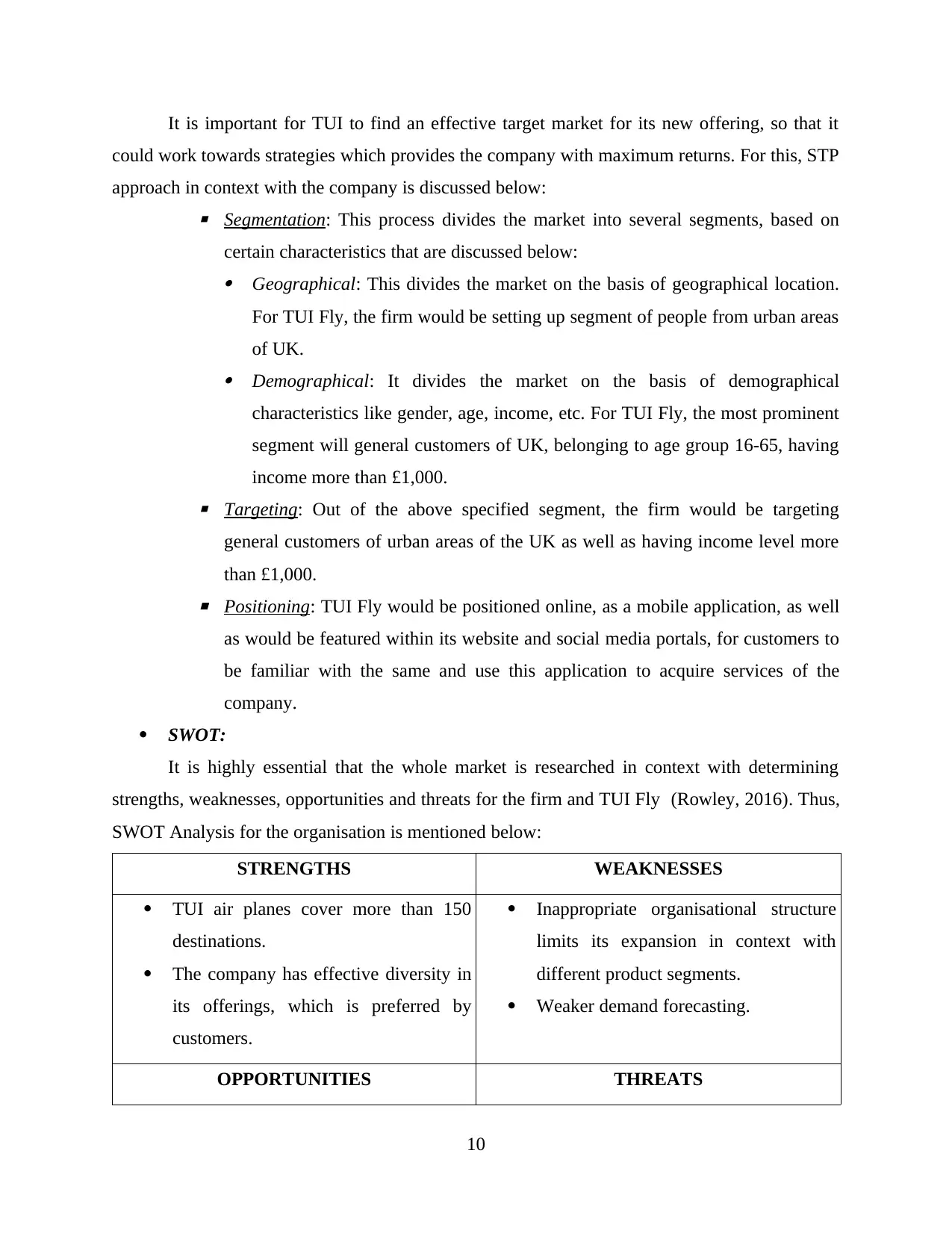
It is important for TUI to find an effective target market for its new offering, so that it
could work towards strategies which provides the company with maximum returns. For this, STP
approach in context with the company is discussed below:
▪ Segmentation: This process divides the market into several segments, based on
certain characteristics that are discussed below:
Geographical: This divides the market on the basis of geographical location.
For TUI Fly, the firm would be setting up segment of people from urban areas
of UK.
Demographical: It divides the market on the basis of demographical
characteristics like gender, age, income, etc. For TUI Fly, the most prominent
segment will general customers of UK, belonging to age group 16-65, having
income more than £1,000.
▪ Targeting: Out of the above specified segment, the firm would be targeting
general customers of urban areas of the UK as well as having income level more
than £1,000.
▪ Positioning: TUI Fly would be positioned online, as a mobile application, as well
as would be featured within its website and social media portals, for customers to
be familiar with the same and use this application to acquire services of the
company.
SWOT:
It is highly essential that the whole market is researched in context with determining
strengths, weaknesses, opportunities and threats for the firm and TUI Fly (Rowley, 2016). Thus,
SWOT Analysis for the organisation is mentioned below:
STRENGTHS WEAKNESSES
TUI air planes cover more than 150
destinations.
The company has effective diversity in
its offerings, which is preferred by
customers.
Inappropriate organisational structure
limits its expansion in context with
different product segments.
Weaker demand forecasting.
OPPORTUNITIES THREATS
10
could work towards strategies which provides the company with maximum returns. For this, STP
approach in context with the company is discussed below:
▪ Segmentation: This process divides the market into several segments, based on
certain characteristics that are discussed below:
Geographical: This divides the market on the basis of geographical location.
For TUI Fly, the firm would be setting up segment of people from urban areas
of UK.
Demographical: It divides the market on the basis of demographical
characteristics like gender, age, income, etc. For TUI Fly, the most prominent
segment will general customers of UK, belonging to age group 16-65, having
income more than £1,000.
▪ Targeting: Out of the above specified segment, the firm would be targeting
general customers of urban areas of the UK as well as having income level more
than £1,000.
▪ Positioning: TUI Fly would be positioned online, as a mobile application, as well
as would be featured within its website and social media portals, for customers to
be familiar with the same and use this application to acquire services of the
company.
SWOT:
It is highly essential that the whole market is researched in context with determining
strengths, weaknesses, opportunities and threats for the firm and TUI Fly (Rowley, 2016). Thus,
SWOT Analysis for the organisation is mentioned below:
STRENGTHS WEAKNESSES
TUI air planes cover more than 150
destinations.
The company has effective diversity in
its offerings, which is preferred by
customers.
Inappropriate organisational structure
limits its expansion in context with
different product segments.
Weaker demand forecasting.
OPPORTUNITIES THREATS
10
⊘ This is a preview!⊘
Do you want full access?
Subscribe today to unlock all pages.

Trusted by 1+ million students worldwide
1 out of 15
Related Documents
Your All-in-One AI-Powered Toolkit for Academic Success.
+13062052269
info@desklib.com
Available 24*7 on WhatsApp / Email
![[object Object]](/_next/static/media/star-bottom.7253800d.svg)
Unlock your academic potential
Copyright © 2020–2025 A2Z Services. All Rights Reserved. Developed and managed by ZUCOL.





